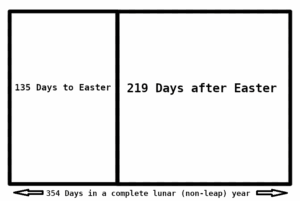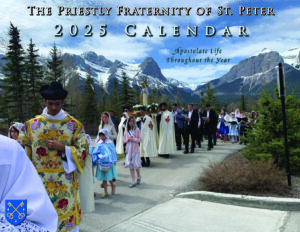The Ninth Month
by Fr. Mark Wojdelski, FSSP
(This is part of a series of articles, and will make little sense without the introductory articles: (1) , (2), (3), and (4). There are more than four articles in the series, but the first four are very important to understanding the conceptual framework.)
Now we will look at Kislev, the ninth month of the Hebrew religious calendar, i.e. the third month of the civil calendar, to see what else might be hiding in plain sight. Something odd will happen between this month and the next month, which we will see when it happens in its proper place, and any suggestions as to what is going on at that point will be more than welcome. Nevertheless, we arrive at the beginning of this month not counting forwards from Easter, but in the backwards direction, and according to that method of reckoning, the first day of the month falls on Saturday, the Sabbath. This is interesting because it just so happens that no matter what, according to the modern Molad1 used by the Jewish people, the beginning of Kislev can never fall on the Sabbath, just as according to their same manner of arranging the calendar, Nisan always has 30 days, whereas in our idealized schema, as has been shown, it must have had 29, at least in those years when it mattered.

The idea of counting days backward before Easter has already been discussed (here) but exactly how far forward and back one should go is not immediately obvious. It might seem that going back only as Septuagesima or the first Sunday after Epiphany or some other arbitrary point might be preferable and our reconstructed lunar year could end with Kislev, rather than the alternative. However, the striking thing about this precise arrangement is that the days before and after Easter are arranged in the so-called golden ratio. 220/134 is within .02 of the “golden ratio” (~1.618).2 Recall that the ordinary lunar calendar of 354 days divides neatly into two halves, each comprised of 177 days. We’ve already seen that pivot points around Easter and Sukkot, and Good Friday and the Ember Friday in September exist, but Christianity takes the lunar year and causes it to undergo an asymmetric fission, as it were, with the point of cleavage being the Feast of Feasts, the Resurrection.3
Regardless of the arrangement of the matins readings of previous weeks, which were arranged according to the solar month, we can be very certain of the readings of the final week after the 24 Sundays of Pentecost. The reading assigned for the day immediately before the beginning of Advent is from the prophet Malachi, the last of the prophetic books of the Old Testament:
The oracle of the word of the Lord to Israel by Malachi.
“I have loved you,” says the Lord. But you say, “How have you loved us?” “Is not Esau Jacob’s brother?” says the Lord. “Yet I have loved Jacob but I have hated Esau; I have laid waste his hill country and left his heritage to jackals of the desert.” If Edom says, “We are shattered but we will rebuild the ruins,” the Lord of hosts says, “They may build, but I will tear down, till they are called the wicked country, the people with whom the Lord is angry for ever.” . . . I have no pleasure in you, says the Lord of hosts, and I will not accept an offering from your hand. For from the rising of the sun to its setting my name is great among the nations, and in every place incense is offered to my name, and a pure offering; for my name is great among the nations, says the Lord of hosts. (Mal 1:1-4,10-11)
The end of this book is also very appropriate:
Behold, I send my messenger to prepare the way before me, and the Lord whom you seek will suddenly come to his temple; the messenger of the covenant in whom you delight, behold, he is coming, says the Lord of hosts. ( Mal 3:1)
For behold, the day comes, burning like an oven, when all the arrogant and all evildoers will be stubble; the day that comes shall burn them up, says the Lord of hosts, so that it will leave them neither root nor branch. But for you who fear my name the sun of righteousness shall rise, with healing in its wings. You shall go forth leaping like calves from the stall. And you shall tread down the wicked, for they will be ashes under the soles of your feet, on the day when I act, says the Lord of hosts.
“Remember the law of my servant Moses, the statutes and ordinances that I commanded him at Horeb for all Israel.
“Behold, I will send you Elijah the prophet before the great and awesome day of the Lord comes. And he will turn the hearts of fathers to their children and the hearts of children to their fathers, lest I come and strike the land with a curse.” (Mal 4:1-6)
These would be the most relevant passages, but the whole book is worth reading; it is not that long. The fact that in our hypothetical calendar this day falls on the Sabbath, the seventh day of the week, is certainly noteworthy. The last day of the week dawns into the first day of the week, the first day of the season of Advent, the beginning of the liturgical year, which might also remind us of the new beginning on Easter Sunday: “Now after the sabbath, toward the dawn of the first day of the week, Mary Magdalene and the other Mary went to see the tomb.” (Mt 28:1)
And then, a few days after that, 8 Kislev, Saturday, the day of the week that eventually became devoted to the Blessed Virgin Mary, at matins we have the following:
And the Lord spoke again to Achaz, saying: Ask thee a sign of the Lord thy God, either unto the depth of hell, or unto the height above. And Achaz said: I will not ask, and I will not tempt the Lord.
And he said: Hear ye therefore, O house of David: Is it a small thing for you to be grievous to men, that you are grievous to my God also? Therefore the Lord himself shall give you a sign. Behold a virgin shall conceive, and bear a son and his name shall be called Emmanuel. He shall eat butter and honey, that he may know to refuse the evil, and to choose the good. (Is 7:10-15)
It’s probably nothing, but such coincidences do seem to happen from time to time. Keep in mind that if there is anything to these distant connections, they are but faint echoes. The main action takes place during the weeks leading up to and following the Exodus. It is hoped that these reflections might continue to help the reader integrate the liturgy and scripture into his life in a new, more profitable way.
1 The tables that are used to calculate when the new moons should fall according to an idealized calculation (see earlier articles for an explanation)
2 The “exact” center is about 5 hours after sunset on Easter Sunday, while the Israelites might have been crossing the Red Sea.
3 The idea of looking for the golden ratio was suggested (after I had intuitively decided how to make the division) by a close childhood friend of mine, Prof. Mark Nowakowski, a music professor at Kent State, who has been working on a book on aesthetics.
November 26, 2025








